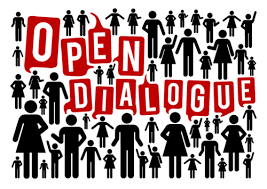The Tao of Dialogical Family Therapy; Toward a Steemit Scholarship Ecosystem
Attention: fellow Steemophiles,
I have not seen anyone post many cited, scholarly or research articles. So I wanted to iterate and move the platform toward rigor in regards to some of the more didactic content. However, this information likely will not be for everyone, and I understand that.
Nonetheless, I believe that this platform can be used to spread highly researched information in an effective manner, and a quasi-"peer review" function can be based on up votes through acknowledgement of the references or works cited section. A tag could even be created to raise the bar in terms of content that is more suitable to electronic libraries and intensive study. This could create a thriving ecosystem for Steemit independent scholars to post their research or literature reviews.
The present work represents a fully fleshed out literature review on the fascinating subject of "dialogical family therapy," which has proven to be effective in helping abate the positive symptoms of schizophrenia, which include delusions and hallucinations. Therefore, this will be of most interest to students of counseling psychology and people interested in psychopathology. I provided as many definitions and outbound links to help clarify the work.
This paper has not been submitted to any professional journal as of yet, but I have been published previous journals.
This suggests that the mother-infant relationship is based on responsiveness and understanding. A mother does not ignore her infant’s gestures, needs, micro-expressions, or other relevant movement, nor does she interact with the child in a one-sided or top down fashion. The connection, in many ways, is anarchic. Every aspect of the baby’s desires is attended and violence is not often employed. The mother functions in perfect lockstep with the baby and vice versa. It is a wholly emotional transaction, based on communication and the dictates of nature for the nurturing of human young (Seikkula, J. 2011). Dialogical family therapists would say this deep bond is the essence of dialogical therapy. They would not say, however, that it is a specific counseling intervention, methodology, or logically applied philosophy. Dialogic therapy is a way of being (Seikkula, J. 2011). It is like the spirituality of Taoism: the therapist does not do much, but simultaneously does a lot. It is a beautiful paradox. A quote from “Tao De Ching” sums up the therapeutic stance, “If you try to change it, you will ruin it. Try to hold it, and you will lose it” (L., & Mitchell, S. 1988). Indeed, in dialogical family therapy, the therapist does not try to change the family; the therapist only listens, empathizes, and responds in kind. In this sense, dialogical therapy is the stuff that conscious and relational life is made of; it cannot be taught in a logical manner. It is a part of the human condition; it is experiential (Seikkula, J. 2011). Dialogical family therapy, then, is the use of listening, reflecting, and feeling within a counseling session in order to help alleviate a trauma or crisis event. Dialogic family therapists owe a debt of gratitude to Carl Rogers, because they emulate Rogerian style of counseling during a session. Counselors who practice open dialogue implement the core conditions of empathy, unconditional positive regard, and congruence, except they may not use the same language as Rogers. Nonetheless, they attempt to attend to their clients with authentic responsiveness and compassionate concern as a mother would her newborn child. They connect with the client by putting themselves inside their world in order to fully understand them and be available for emotional rapport (Trimble, D. 2002). Seikkula shared some thoughts on Bakhtin’s view, “Bakhtin understood dialogue as the condition for the emergence of ideas. It is in the particularities of exchanges between persons in the moment that meaning develops, not within either party’s head, but rather, in the interpersonal space between them” (Seikkula J, 2003). When Bakhtin initially wrote about dialogism, he was using it as a perspective for literary critique, and he employed it to analyze the characters within Russian novelist Dostoyevsky’s work. It was not originally a work geared toward counseling, but it has since evolved into a therapeutic mainstay. Open dialogue has also been influenced by postmodernist theorists and social constructivists. These narrative type approaches fit nicely with open dialogue therapy, because everyone involved acts as co-creators within the evolving poetry of the therapy process. What matters is the intersubjective world of the participants, and how they relate to one another in the space provided. Most germane to the process is the particular aesthetic and expression of the relationship between all voices within the therapeutic conversation. It is largely about communication, listening, and existence. It is about sharing and authoring of new stories within the confines of a curative environment. And it is premised on the notion that each person constructs their own reality, and the meanings and metaphors within that reality are not necessarily shared by others, which flows along the same stream as social constructivist thought. It is a wholly phenomenological perspective, and understandings must come to be adopted and understood by all participants of the dialogue if change is to occur. In addition, dialogism also has its therapeutic history in the work of an anthropologist and philosopher named Gregory Bateson. He was known for his intriguing collection of essays called, “Steps to an Ecology of Mind” (Bateson, G. 1972). In this work, Bateson addressed the problem of schizophrenia. He believed it was a communication problem rather than a biological disease. He proposed the issue of double-bind communication as what plagues many schizophrenics (Bateson, G. 1972). This is a situation where a person is a victim of conflicting demands that are imposed on them in confusing ways. The importance of Bateson’s work with double-bind communication manifested in his notion that psychotic speech and behavior could be viewed as adaptive rather than maladaptive if everyone involved resonated on the same wavelength as the sufferer and existed in the same communicative context (Seikkula, J., & Trimble, D. 2005). It was this understanding of Bateson’s work and early use of Milan Family Systems therapy, along with Bakhtin’s ideas of dialogism that encouraged therapists in Lapland, Finland to begin work with psychotic clients and their families during the 1980’s (Seikkula, J., & Olson, M. E. 2003). They initially started use of open dialogue family therapy with a “network-based” approach. The network approach denotes interconnection between a family, significant others, friends, and a team of therapists (Seikkula, J., & Olson, M. E. 2003). Milan therapy was also built on a systems or cybernetics approach, but it was usually employed as a top down practice. It focused on hypothesizing, questioning, circularity, which are active interventions based on a more directive approach (Seikkula, J., & Olson, M. E. 2003). It was not a a treatment that focused on responding and empathizing, and it did not tune network members to the same emotional frequency as with the dialogical therapeutic position. As a culmination of their interests and the previous work of Bateson, the team in Lapland, Finland centered their efforts on working with schizophrenic clients or clients who have been suffering bouts of psychosis. This approach heralded the birth of open dialogue family therapy as it exists today (Seikkula, J., & Olson, M. E. 2003). Current psychiatric modes of thought tend to characterize schizophrenia as a lifelong debilitating condition, which requires medication throughout life. The outcomes for schizophrenia sufferers also seem to be poor, and the psychiatric drug literature does not bode well for clients over the long-term. However, in Finland, the research suggests that dialogic family therapy is efficacious in helping abate some of the positive symptom outbreaks in this population. The positive symptoms of schizophrenia primarily include delusions and hallucinations. These can be auditory or visual or both. Research conducted by Seikkula’s Finland team stated, “During the entire 5-year period, 29% of ODAP (Open Dialogue Approach) group patients had at least one relapse versus 39% of API patients (Seikkula, J., et al 2006). The initial findings for outcomes on relapse where not statically significant, but there are signs the research showed positive outcomes. There have been multiple studies by the same team, and almost all of their results have been favorable in regards to cases of individuals who have been dealing with the emergence of psychotic and other problematic symptoms. This means that open family therapy has worked to reduce instances hallucinations and delusions in these populations. But why does it seem to work? The reason why dialogic therapy works so well in preventing relapse symptoms in these populations is because of the acute nature of dialogic interventions. The Finland model is set up to intervene on a psychotic crisis with a family on a moments notice (Seikkula, J., et al 2006). This immediate response, including the non-coercive and open nature of the meeting allows for new communication to emerge between network members. The fact that therapists work in teams may also help improve outcomes. The dialogic process is set up in such a way so that teams can join in as part of the network, but also speak among themselves during the process. It is this total availability, openness, and sense of concern that spurs schizophrenic affected person to communicate their crisis and symptoms in novel ways (Seikkula, J., & Trimble, D. 2005). This opens up all members of the network, including family, to new views regarding the nature of the hallucinations and delusions. In other words, it provides context to the experiences expressed by the identified patient (Rober, P. 2002). And whereas systemic or structural family therapies may view the problem as residing within the structure or relationship between family members, the dialogic therapists see narrative and communication between the family members as the crux of the issue. Thus, dialogic therapists do not attempt to impose structure changes or use directive approaches in the therapeutic process. They only listen and respond to the family members in a spontaneous fashion (Lidbom, P. J. 2014). This illustrates the major difference between a monological and dialogical style.
Brief Abstract
In this paper I covered a brief history, the main ideas, and applications of dialogic therapy, or “open dialogue” to family therapy settings. Dialogical family therapy was derived from the philosophical work of Russian philosopher and linguist Mikhail Bakhtin. He was responsible for introducing the concept of “dialogism," as well as writing about the influence of “polyphony” within Russian literature, especially in the novels of Fyodor Dostoevsky.
The Tao of Dialogal Family Therapy
At the very first moment of life, human beings are birthed into a relational atmosphere characterized by intense feelings, empathy, and nurturing warmth. It is a type of emotional communion between mother and infant. This delicate dance of attunement has been described as dialogical (Seikkula, J. 2011).
A Short History of Open Dialogue Therapy
Dialogical therapy has its roots in many disparate concepts, therapies, and philosophies. Most influential to open dialogue family therapy has been the dialogism of Russian philosopher and linguist Mikhail Bakhtin, which he elaborated on in his book of essays, “The Dialogic Imagination” (Bakhtin, M. M. 2010).
Dialogism with Schizophrenic Clients and Their Families
The most impressive aspect of the dialogic approach is that it is most efficacious when used in acute crisis settings regarding clients suffering from the positive symptoms of schizophrenia (Seikkula, J., Aaltonen, J., et al, 2006).

Monologic Versus Dialogic
The key element of successful interventions with dialogic therapy is the continued presence of dialogic communication in a session. This implies that monological communication must not be used in the context of therapy. Monological discourse by definition denotes a top-down rather than horizontal approach. It means that the therapist is giving direction, advice, or acting as an authority figure in the relationship with the clients.
Most significantly, this method negates any chance for dialogue. It means that responsiveness and emotional sharing is not taking place. Dialogical Researchers have suggested that the monological approach stymies the identified patients from communicating all the possible feelings, intuitions, ideas, and insights they have in regards to their subjective experiences.
The monological approach also stifles the totality of communication by all network members within the session.
In one article, Wilson refers to this as “monological entrapment” (Wilson, J. 2015). This occurs when the therapist forgets about the process of listening, responding, and taking on a Rogerian stance, and instead acts as an authority on the lives of the family and begins to dictate or manage the session. This could also occur if the therapist is not paying keen attention to the cues, body language, and expressivity of the family.
Wilson elaborated on his position, “When our minds are cluttered with explanatory theories, or preoccupied with other concerns it is understandable that we are tempted to fall back on certainties: truths about a matter and the like” (Wilson, J. 2015).
When this happens, family members may not feel comfortable communicating their emotions in the session. They may feel more judged and apprehensive about the situation. They certainly will not feel cared for in the moment by the network team members, nor will they be open enough to comprehend what their loved one is trying to communicate, who may be suffering from a psychotic episode.
And openness is needed, because it is the multiplicity of compassionate voices that brings the healing process to life within the dialogue therapy session (Seikkula, J., & Olson, M. E. 2003). For this openness to occur, there are three major components to dialogical family therapy that make it a powerful tool within acute crisis family sessions

Three Components of Open Dialogue Therapy
Polyphony
The multiplicity of voices communicating in tandem is what brings the dialogical process to life. This component of the therapeutic process has been referred to as polyphony. The whole aim of open dialogue is to involve as many people as possible in true and open communication (Seikkula, J., & Olson, M. E. 2003).
This means many speakers and listeners are active. But it does not imply that just one voice comes over and drowns out the rest. If polyphony is being constructed properly in the session, than a whole new vista of emotional information is conveyed, new or profound understandings are reached, and new insights are brought to bear regarding the problem (Wilson, J. 2015).
Since this form of therapy is based on the network approach, for polyphony to manifest in the environment, it means that the team of therapists must pay attention to all the emotional details within the session. They must demonstrate that they care, and ask appropriate questions guided by their emotionally intelligent understanding of context and meaning. It is also appropriate for the team members to point out observations they make to other team members in order to cue total interest and empathic attunement from the members of the network (Seikkula, J. 2011).
The team members must also pay attention to body language. Body language conveys emotional material better than verbal dialogue, and discrepancies can also be noted between a member’s verbal language and body language. However, within open dialogue therapy, confrontation is rarely used, because most acute sessions are traumatic in nature or based on a crisis event.
With that said, if all the network voices are heard properly and attentiveness and listening skills are employed, then new and novel meanings can shine light on previously uncharted territory within the social-contextual realm of the clients.
It are these new meanings and explanations that allow families to come to beneficial understandings regarding the problem, and possibly grant insight into as to why a family member entered a psychotic state. On rare occasions, this use of polyphony can actually end psychotic communication upon a first meeting (Seikkula, J., & Olson, M. E. 2003).
Dialogism
Dialogism is the keystone of open dialogue therapy. It is the idea of capturing the space between individuals, in what philosopher Martin Buber referred to as the “I-Thou” relationship (Inger, I. B. 1993). It is this relationship between individuals where understanding and misunderstanding occur.
Within dialogue, misunderstanding happens because of a lack of listening, and the communication efforts are bungled. For dialogue to work properly, there must individuals who are totally devoted to understanding, which includes listening and responding with full empathy. The individuals must not interrupt the speaker, employ subterfuge, or have disdain for the speakers, because this may corrupt their own ability to listen compassionately and with concern.
Some would say that this kind of atmosphere creates a sense of shared love. It is true that dialogism has an affinity for sparking the emotions that create change, and lead to feelings of love between individuals.
In the network environment, this includes all family members, therapists, and other social relations. Love in this milieu is directly correlated with emotional attunement and a sense of belonging with other network members. It is the cornerstone of the Tao perspective within empathic therapeutic approaches such as open dialogue.
This is what Seikkula had to say about this in relation to team membership, “As the original network incorporates the team into its membership, new meanings emerge when new shared language starts to emerge between the team and members of the social network. The drama of the process lies not in some brilliant intervention by the professional, but in the emotional exchange among network members, including the professionals, who together construct or restore a caring personal community” (Seikkula J, 2005).
Dialogism revolves around the idea that network members actually care about the identified patient and family members. Since network members are understood to be listening and involving themselves emotionally, it provides leeway for all network contributors to speak without fear or hesitation. If true dialogism is not used, and members employ monological communication, the whole environment might breakdown and become disrupted; there will no detoxification of symptoms and no healing.
Lastly, but most importantly, dialogism revolves around mobilizing clients to leverage what psychological resources they have to solve the problem and cope with issues. There are 7 principles as pointed out by Seikkula that network members must employ to make this mobilization of resources possible:
- There has to be an immediate response within 27 hours by the therapist team (Seikkula J., 2011).
- The team must use a social network perspective that makes certain all team members, social supports, and auxiliary members are involved (Seikkula J., 2011).
- The network team must remain flexible and adaptable to the demands and current resources of the family they are working with (Seikkula J., 2011).
- There must be a sense of responsibility within the elected team member to make sure the first meeting occurs within the time frame, and goes off without a hitch (Seikkula J., 2011)
- There must be a psychological community developed in the area in order to guarantee the quick response, as well as involve child psychiatrists and other mental health care professionals as quickly as possible (Seikkula J., 2011).
- Dialogicity must occur in order for an understanding of the problem to crop up so that counselors may act in a responsive manner to leverage internal resources of the clients (Seikkula J., 2011).
- Tolerance of uncertainty must be adopted by the therapists so that they understanding the wayward and unknown directions the therapeutic process may take (Seikkula J., 2011).
Tolerance of Uncertainty
Tolerance of Uncertainty is one of the most important components of the dialogic process. It means that the therapist must maintain a station of unknowing as far as the content and direction of the therapeutic process. The therapy will be spontaneous and based on emotional needs and direction of the network team. This idea returns to ideas regarding the Chinese spiritual tradition of Tao.In Taoism, the way of nature is unveiled through paradox. Water may be soft and pliable, but it is water that can alter the surface of the hardest rock. This notion implies that the process is like water and the problem is like rock.
With this in mind, the therapist acts as the conductor of water by genuinely listening and responding to the family. If he is able to leverage his empathic and soft nature in this regard, the family may be able to change, and the identified patient’s psychotic episodes may abate as in the dissolving of a rock in the current of water.
For example, if a family comes in and their teenage daughter just experienced psychotic instances, where she started hearing voices, the network team should allow the family to enter into dialogue (Seikkula, J., & Trimble, D. 2005). The therapists should not try to promote an agenda or direct the conversation.
If the therapists falter, it could create a monological environment and spoil the spontaneous nature of recovery within the network assembly. It would undermine the watercourse way that the therapist tends to take in order to help the family utilize their own resources for change.
The reason that therapists have to adhere to tolerance of uncertainty in open dialogue therapy is because the family has to have full ability to communicate the problem on their terms. The purpose of this concept is so that different ways of understanding can be reached.
This type of tolerance requires a therapist to drop his guard and pay attention to the set and setting of the environment, which implies paying attention to the nature of dialogue. He must listen and respond and stay with the clients. Any attempt to alter the transaction could curb the process and make the environment less amenable to the change process for a variety of the aforementioned reasons.
Dialogical Therapy in the United States
One of the largest problems with dialogic therapy is that it has not found widespread acceptance in the United States. Mostly, dialogic therapy has taken hold in Scandinavian countries, mainland Europe, and Britain.
One of the primary reasons for this the way that mental health care is handled in the U.S. Currently, most treatment coverage is handled by HMO’s, and these provides place certain restrictions on the method and type of therapy that is used (Stockmann, T. 2015). This way of handling mental health has greatly reduced the chances of this type of care being picked by many practitioners, even though it has great efficacy in regards to family therapy and helping schizophrenic populations (Stockmann, T. 2015).
These therapies are easier to implement with the use of network teams in Finland and elsewhere because of the way their care system is set up. The claim is that socialized medicine allows for this to happen, but there are more realistic reasons.
In Finland, the researchers in Lapland have had a history of dealing with family trauma and crises. Prior to actually starting the network based dialogic approach, these therapists were wedded to the idea of using Milan systems therapy (Seikkula, J., & Olson, M. E. 2003). There has also been a tradition of group care that focused on dealing with psychotic episodes.
Essentially, their whole culture is steeped in a societal wide tradition of family care and formulated toward dealing with acute psychotic episodes.
Conclusion
Dialogic therapy is a form of therapy that relies on the use of true love to spur change. There are no gimmicks or interventions involved.
It is as simple, but it is also challenging. It is akin to the mother-infant relationship upon the first moments of birth. The two have an immediate empathic understanding and connection, and the mother performs her emotional duties in a seemingly effortless fashion. And the baby responds in kind. This can be considered the initial dialogue of life from whence all other dialogues are born. It is communicative and natural. The voice of the child is heard by the mother, and she attends and responds to this voice with a nurturing love.
Thus, in open dialogue family therapy the therapist team and total network are like paternalistic caregivers performing empathetic and communicative functions in a wholly naturalistic way.
There is no magic intervention, or other top-down function that the therapist interposes on the session or clients. There is only a dialogue of love; only voices that issue in the room and are accepted unconditionally by counselors and family members. It is through this process that the family members are able to understand a troubled family member, who may be suffering from schizophrenic symptoms. And if that individual is heard, and all network members empathize and are also heard, both change and healing take place within the therapeutic context.
The key ideas within this type of therapy include dialogism, polyphony, and tolerance of uncertainty.
In this regard, the therapeutic environmental is almost anarchic. There is no hierarchy in the relationship, no one with authority or power. There is only a communion hinged on the power of love. And when this type of environment is created and maintained, its efficacy to spur healing in people suffering from psychosis is tremendously powerful. Just like in the Tao, the therapist appears to do nothing, while at once creating environment rife with love.
References
Bakhtin, M. M. (2010). The dialogic imagination: Four essays (Vol. 1). University of Texas Press.
Bateson, G. (1972). Steps to an ecology of mind: Collected essays in anthropology, psychiatry, evolution, and epistemology. University of Chicago Press.
Brown, J. M. (2010). The Milan Principles of Hypothesising, Circularity and Neutrality in Dialogical Family Therapy: Extinction, Evolution, Eviction ... or Emergence?. Australian & New Zealand Journal Of Family Therapy, 31(3), 248-265.
Brown, J. M. (2012). Theory, practice and use of self in the open dialogues approach to family therapy: A simple complexity or a complex simplicity?. Australian & New Zealand Journal Of Family Therapy, 33(4), 266-282. doi:10.1017/aft.2012.36
Inger, I. B. (1993). A dialogic perspective for family therapy: the contributions of Martin Buber and Gregory Bateson. Journal of Family Therapy, 15(3), 293-314.
Hartman, D., & De Courcey, J. (2015). Family Therapy in the Real World: Dialogical Practice in a Regional Australian Public Mental Health Service. Australian & New Zealand Journal Of Family Therapy, 36(1), 88-101. doi:10.1002/anzf.1088
Lidbom, P. J. (2014). A Study of a Network Meeting: Exploring the Interplay between Inner and Outer Dialogues in Significant and Meaningful Moments. Australian & New Zealand Journal Of Family Therapy, 35(2), 136-149.
L., & Mitchell, S. (1988). Tao te ching: A new English version. New York: Harper & Row. Reed, A. (2013). Therapist attentiveness and negative capability in dialogical family meetings for psychosis. Journal Of Family Therapy, 35(4), 427-440 14p. doi:10.1111/j.1467 6427.2011.00580.x
Rober, P. (2002). Constructive hypothesizing, dialogic understanding and the therapist's inner conversation: some ideas about knowing and not knowing in the family therapy session. The Journal Of Marital And Family Therapy, (4), 467.
Wilson, J. (2015). Family Therapy as a Process of Humanisation: The Contribution and Creativity of Dialogism. Australian & New Zealand Journal Of Family Therapy, 36(1), 619. doi:10.1002/anzf.1095
Seikkula, J. (2011). Becoming dialogical: Psychotherapy or a way of life?.Australian and New Zealand Journal of Family Therapy, 32(3), 179-193.
Seikkula, J., Aaltonen, J., Alakare, B., Haarakangas, K., Keränen, J., & Lehtinen, K. (2006).Five-year experience of first-episode nonaffective psychosis in open-dialogue approach: Treatment principles, follow-up outcomes, and two case studies. Psychotherapy research, 16(02), 214-228.
Seikkula, J., & Olson, M. E. (2003). The open dialogue approach to acute psychosis: Its poetics and micropolitics. Family process, 42(3), 403-418.
Seikkula, J., & Trimble, D. (2005). Healing elements of therapeutic conversation: Dialogue as an embodiment of love. Family process, 44(4), 461-475.
Stockmann, T. (2015). Open Dialogue: A New Approach to Mental Healthcare.Retrieved March 30, 2016, from https://www.psychologytoday.com/blog/hide-and-seek/201507/open-dialogue-new-approach-mental-healthcare
Stern, D. (1993). The role of feelings for an interpersonal self. In U. Neisser (Ed.), The perceived self: Ecological and interpersonal sources of self-knowledge (pp. 205–215). New York:Cambridge University Press.
Trimble, D. (2002). Listening with integrity: The dialogical stance of Jaakko Seikkula. Journal of Marital and Family Therapy, 28(3), 275-278.

My name is Sterlin. I am the Psychologic Anarchist. Find me over at Psychologic-anarchist.com, on Facebook, or on YouTube, where we are trying to build more compassionate and loving anarchist communities. We also discuss psychology, therapy, communication, and the many faces of love.


I up-voted for you but I'll have to read it later tonight looks very detailed and I look forward to sitting down with a glass a wine and having a look. 😉
A glass of wine sounds good! Lol.
Indeed! 😉
Great post bro , but it need an hour to read all this and 2 hours to understand, thanks for the info
Haha. No problem. I tried to break it down into the sections of specific information, as well as provide definitions to help the process. I am also open to any questions. Thanks, Ben! :)
actually I have a proposition, can you write just 1 idea per post and explain it? it's really hard to read all of this
I already do that. My last two posts were less than 500 words. Like I said, this one will not be for everyone, but I believe there is an audience for this material here. I took a risk with this, and if it falls flat, I just won't post longer material. But I am attempting to iterate in regards to the content.
that a good work bro , can I also give you a peace of advice: try to up-vote people who comment for you and all conversations, to keep your post alive and get more up-vote for your post , try to make your post famous
Never seize to blow my mind.
I appreciate your support and commentary here on Steemit, friend. Please let me know if you start posting yourself and I will assist you.
Thank you :) I did post my intro, but that is all so far. Im not much of a writer..I wish I was as I have so many great ideas and things to share.
Awesome. Practice makes perfect. I will check out your intro.
I hope my post was valuable in some way.
This is the longest post that i have seen yet on steemit :D
How long it took to write this?
Heh. Yeah, I haven't seen anyone post their legitimate research.
Including the research I did, probably 6 months total.
That is crazy! u have a lot of patience 👍
Heh. This is pretty common if you are working on a masters degree in a graduate level program. But I definitely appreciate the compliment. :)
I hope you enjoy the work. I don't really expect too many up votes because of the length, but I worked hard on it.
Don't worry your hard work will be appreciated! I aks Dory and she will call whales

.... this is a long, academic and worthy post. I have personal experience in dealing with a close relative diagnosed with paranoid schizophrenia , I have undertaken courses and read many, many books and studies expressed in the kind of language you use. I can deal with it , I understand it but by its very structure it is isolating and somewhat alienating. My feeling is that something more colloquial is needed so that the concepts you are expressing can be understood at a very personal level. If you would like to collaborate on something together lets talk more. In all cases I wish you well.
Thanks so much for your honesty and thoughts on the matter. However, do please bear in mind that I mention in the introduction that this work is not intended for every reader, and thus my post was not to just to gain up votes. All my other blog topics are shorter in length and more colloquial as you stated. I just wanted to iterate and appeal to people who appreciate scholarship. That said, this may not be as valuable to most people here, but I want to appeal to those who enjoy reading work that is highly researched and topic intensive. If I fail, that is okay. I will continue appealing to the common reader.
And yes sir, I am game to collaborate, especially since you have a relative diagnosed with schizophrenia. Let me link a shorter piece I wrote on this same topic. Here it is:
https://psychologic-anarchist.com/2016/03/19/psychological-anarchy-curing-schizophrenia-through-talk/
...Thanks for your response , I have followed you in order to stay in touch with such an important subject .
I for one appreciate the academic links . This subject deserves more public awareness and thank you for bringing it to light
It's nice to see something of this quality and rigor on here. I'm following your work! I hope we have a way of publishing academic papers on a blockchain in the near future, as @pharesim and others have suggested. Would you be interested in that?
I had never heard of Bakhtin, and am interested in what he had to say about Dostoyevsky, who is one of my favorite authors.
Thanks a lot Edgeland. And I would certainly be interested in that. As I continue my academic career I will write more and more research papers.
Also, I think you will enjoy Bakhtin then. He mainly looked at the polyphony, or the dialogue between each of Dostoevsky's characters.
That's excellent. Maybe you can be a beta tester for the academic research blockchain, in the area of psychology.
How interesting that he calls the dialogue "polyphony." The dialogue in "The Brothers Karamazov" and "Crime and Punishment" is so emotionally intense and tortured at times.